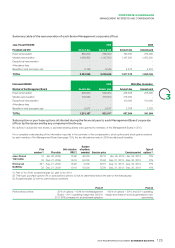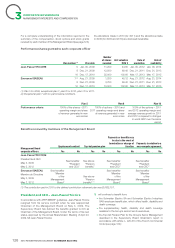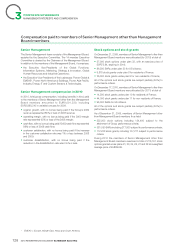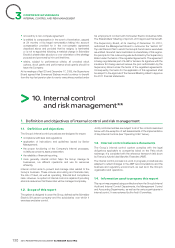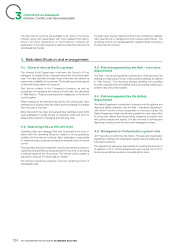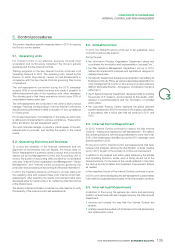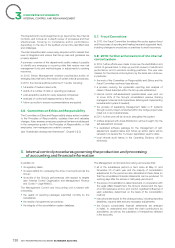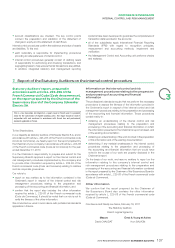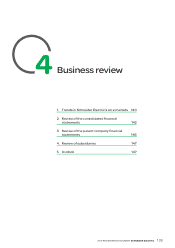APC 2010 Annual Report Download - page 137
Download and view the complete annual report
Please find page 137 of the 2010 APC annual report below. You can navigate through the pages in the report by either clicking on the pages listed below, or by using the keyword search tool below to find specific information within the annual report.
CORPORATE GOVERNANCE
3
INTERNAL CONTROL ANDRISKMANAGEMENT
5. Control procedures
This section describes specifi c measures taken in 2010 to improve
the Group’s control system.
5.1. Operating units
For internal control to be effective, everyone involved must
understand and continuously implement the Group’s general
guidelines and the Key Internal Controls.
Training programs on the Key Internal Controls continued in all
Operating Divisions in 2010. The operating units, trained by the
Division to which they belong, carried out self-assessments in
compliance with the Key Internal Controls governing their scope
of operations.
The self-assessments conducted during the 2010 campaign
covered 90% of consolidated revenue and made it possible to
defi ne improvement plans in the operating units, when necessary.
The ultimate goal is that these evaluations should cover 80% of
consolidated revenue each year.
The self-assessments are conducted in the units by each process
manager. Practices corresponding to the Key Internal Controls are
described and performance is rated on a scale of1 (non compliance)
to4 (very good).
For all responses below3 (compliance) on the scale, an action plan
is defi ned and implemented to achieve compliance. These action
plans are listed in the self-assessment report.
The unit’s fi nancial manager conducts a critical review of the self-
assessments by process, and certifi es the quality of the overall
results.
5.2. Operating Divisions and business
To control the reliability of the financial statements and the
alignment of performance with set targets, the Group relies on
Senior Management’s quarterly review process and procedures
carried out by the Management Control and Accounting Unit to
control the quality of accounting data provided by consolidated
units (see “Internal Control organisation and Management – Senior
Management” and “Internal control procedures governing the
production and processing of accounting and fi nancial information”).
In 2010, the Operating Divisions continued to provide training for
the operating units and received these units’ internal control self-
assessments. After analysing the results, improvement plans were
developed either for certain units or for certain Key Internal Controls
at the Division level.
The Division internal controllers conducted on-site missions to verify
the reliability of the internal control self-assessments.
5.3. Global Functions
In 2010, the Global Functions continued to set guidelines, issue
instructions and provide support.
During the year:
•the Information Process Organisation Department steers and
coordinates the formulation and implementation “process One”;
•the Risk Solutions Management Department, set up in 2010,
defi nes and implements principles and applications designed to
manage these risks;
•the Security Department developed an application centralising all
Business Continuity Plans, as well as a specialised application for
crisis management at country or Group level. It is used whenever
SEECC (Schneider Electric – Emergency Coordination Center) is
called upon;
•the IT Systems Security Department developed skills for auditing
the security of IT systems, and conducted its fi rst audits, which
resulted in recommendations and the formulation of remedial
action plans;
•the Corporate Treasury Center deployed the global payment
system developed in 2009 in more than 30 European subsidiaries,
in accordance with a rollout plan that will continue in 2011 and
2012.
5.4. Internal Control Department
In 2010, Internal Control continued to deploy the Key Internal
Controls – training and requests for self-assessments – throughout
the Operating Divisions, with the scope extended to cover new units:
50% of the weaknesses identifi ed during the 2010 campaign were
deemed settled in 2010.
By the end of 2010, Internal Control self-assessments had been
received and analysed, allowing the identifi cation of areas needing
work in 2011 as part of the process of continuous improvement.
In addition to the analysis and action plans initiated by the Entities
and Operating Divisions, similar work is being carried out in the
Global Functions. On the basis of the results obtained in their fi eld,
the various functions defi ne and implement improvement actions
as needed.
In the meantime, the list of Key Internal Controls continues to grow.
In 2010, work aimed at adjusting the self-assessment questionnaires
in line with the organisational principles of the One program continue.
5.5. Internal Audit Department
In addition to fi ne-tuning the general risk matrix and performing
audits to ensure these risks are managed properly, the Internal Audit
Department:
•monitors and reviews the way that Key Internal Controls are
applied;
•critically reviews the audited unit’s internal control self-assessment
and related action plans.
2010 REGISTRATION DOCUMENT SCHNEIDER ELECTRIC 135


